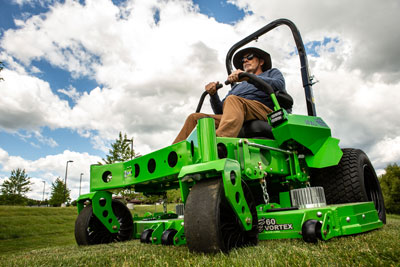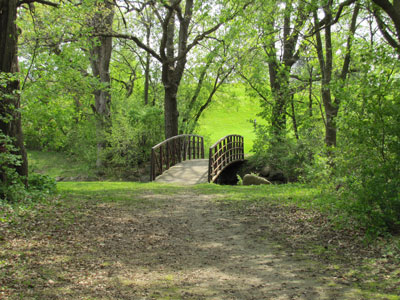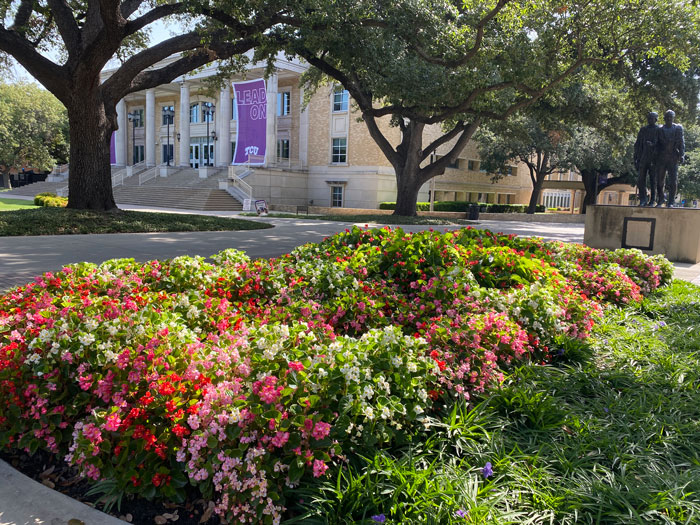When the recent pandemic dictated social distancing and drastically limited indoor recreation opportunities, more people began utilizing outdoor spaces including parks, trail systems, sports fields and campuses. And according to many who oversee these spaces, that trend continues, putting even more strain on these amenities. And for those who manage and maintain grounds, it’s a never-ending mission to keep their landscapes beautiful, healthy and welcoming to users, oftentimes with limited budgets and resources.
Sun Prairie, Wis.—a Madison suburb—has around 37,000 residents and more than 400 acres of parkland, maintained by seven full-time field staff and five temporary seasonal workers, according to Kristin Grissom, director of parks, recreation and forestry for the city. In her seven-year tenure they’ve added five new parks with three more slated for development in coming years. “Growth and development have been great, but also very challenging as we’ve continued to have more parkland dedicated to us without receiving more crew members.
“When people find out how small our crew is, they’re often shocked,” said Grissom, who described how they’ve “adjusted, prioritized and remained nimble” to stay on top of tasks. She lauded her crew’s commitment and passion, which makes “all the difference in being able to accomplish so much with so few people.”
And as more people are utilizing outdoor spaces, it seems that more of them are also taking stewardship of these spaces, which can be another tool in a grounds manager’s playbook. “In 2023, we rolled out a volunteer program to provide some much-needed help as we have a very engaged community full of people willing to help,” said Grissom. The Park Stewards program has volunteers helping out anywhere from one to 20 hours a month, performing skilled tasks such as herbicide spraying—which requires experience and training—or other tasks such as invasive weed pulling and litter cleanup.
Sun Prairie is committed to professional development for staff at all levels, according to Grissom, and crews are encouraged to specialize in functional areas, which might mean becoming an arborist or getting certified in pesticide application or playground safety inspection. They also budget money to ensure crews have opportunities to attend various industry conferences around Wisconsin.
Grissom listed some of the regular duties crews perform, including mowing, trash removal and shelter cleanup, weeding,

storm damage cleanup, playground inspection and repairs, event setup and takedown, and the winterization and de-winterization of shelters, the aquatic center and splash pad. They also perform project management and tasks for capital projects such as site prep for playground replacement projects and onsite problem-solving for shelter construction.
Sun Prairie has about 30 miles of paved trails plus a handful of mowed and gravel trails. Sheehan Park, which features “a variety of landscapes from unmanaged woodlands to native prairies and everything in between,” also hosts the city’s mountain bike trails, and Grissom explained that they’ve partnered with a local mountain biking group to “assist with the maintenance of the mountain bike trail system. Annually, they bring out dozens of volunteers to help with maintenance, trash pickup and invasive species removal.”
When it comes to flowers and plants, Grissom said they “lean more toward perennials in our parks and annuals in more facility-based ornamental plantings.” And she said they’re working to feature native planting areas in each one of their 45—and growing—parks. “Our pollinator gardens have been extremely successful and well-received. Many volunteer groups have interest in taking these on as projects. We also have a volunteer-run community garden and a nonprofit-managed community garden that we provide maintenance and support for.”
There’s also a forestry division in Sun Prairie, led by Cindy Burtley. “It’s because of her that her team is so energetic, positive and have pride in what they do,” said Grissom.
Parks and forestry share a building and equipment, and parks crews help with pruning in winter months and cleanup after storms. Forestry manages more than 10,000 trees, which includes pruning, removals, planting, watering and mulching, maintaining GIS tree inventory, tree risk assessments and consultations, education and outreach, and more.
The nonprofit Professional Grounds Management Society (PGMS) is an individual membership society of grounds professionals, “advancing the profession through education and professional development.” Their annual Green Star Awards program brings national recognition to grounds maintained with a high degree of excellence. In 2023, Texas Christian University (TCU) won the Grand Award in the University & College Grounds category, midsize schools.
The TCU campus in Fort Worth features 300 acres of carefully manicured grounds, with “around 55 team members that take care of all the grounds, athletic fields, trees, flowers, shrubs, irrigation, trash, concrete, hardscapes, football tailgating cleanup and many other duties,” said Erik Trevino, director of landscape and grounds, who added that the grounds positions are “full-time, salaried, full benefits positions.” TCU also offers a tuition benefit for employee’s families, which Trevino said many workers have taken advantage of.
TCU ground crews include four licensed irrigators, three certified pesticide applicators and an arborist, according to Trevino. “We’re fortunate to have vendors who partner with us for frequent training on general safety, proper pesticide application, proper tree care and protection and safe use of equipment.” And he said several team members had recently attended a supervisor training seminar, “specifically geared toward frontline, university supervisors.”
Creating a “beautiful, year-round display of amazing flowers” is a goal at TCU, said Trevino. “We have over 50 annual color beds with 25,000 total flowers that are changed out at least two times per year, (and) some are changed out three or four times per year. In late fall, we plant tulip and hyacinth bulbs that provide an incredible spring bloom. Folks come from all around to take pictures of our tulip displays!” He said they have a great greenhouse team that grows about half of the annuals, with the rest supplied by local vendors.
Trevino, an International Society of Arboriculture-certified arborist, explained how decades ago, university planners planted live oaks along all campus roadways, “resulting in a gorgeous canopy that borders our campus, providing shade and tranquility for the campus community.” There are now more than 3,000 trees on campus, and they continue to plant trees every year on Arbor Day and Texas Arbor Day.
In accordance with local water restrictions, Trevino said they water only twice a week. “Because our irrigation team has faithfully followed these watering guidelines for over a decade, our plants are accustomed to the infrequent, deep watering that encourages deep root growth.” He believes that in the extremely hot and dry summers of 2022 and 2023, this is why the campus landscape fared much better than surrounding sites. “Our irrigation team is also very hands-on with our monthly preventive maintenance irrigation checks and in our setting of ‘rain delays’; manually turning off irrigation for as many days as possible after rain,” which he said saves thousands of gallons of water annually.
TCU boasts a storied sports program, and as part of the grounds team, “we have an incredibly talented athletic field team that cares for our natural grass fields including football stadium, football practice fields, soccer field, baseball field and two large intramural field complexes.” He said their sport turf manager uses his experience and knowledge of sports turf science to provide “the best playing surfaces in the country. This includes mowing, fertilizing and disease control, striping the lines, numbers and logos, and a vast array of cultural practices including aeration and topdressing.”
Grissom said that while they do oversee sports fields, they also have help. Since local nonprofit youth sports organizations are the primary providers for sports in the community, “we have written agreements with our local youth soccer and baseball groups to maintain the fields.” Parks crews plan annual maintenance projects and perform some duties like mowing the soccer fields, “but the Sun Prairie Soccer Club takes care of lining them, aeration, seeding, rolling, etc.”
And recently they’ve also worked out an agreement with their youth baseball group to do the mowing and lining of the diamonds and fields used for the adult softball programs, “in exchange for having first right of refusal to use them when the city is not. This has been a win-win arrangement for us as we continue to gain parkland yet not more staff; it frees our crew up for other needed tasks.”
In Aurora, Ill., Aurora University also won a 2023 PGMS Green Star Award: the Grand Award in the University & College Grounds category, small schools. Jeff King is chief operating officer at the school, and he said they’ve subcontracted a lot of the grounds maintenance, such as the athletic fields, to an outside firm, though they usually maintain six or seven full-time employees as well, plus a couple of part-time student workers.
According to King, the most frequent duties for those employees include mowing, trimming, blowing, edging and pulling weeds. Other less frequent tasks include “tree trimming, trimming bushes, mulching, adding stone when needed, watering, planting trees to replace anything that needed to be removed and making sure sticks and garbage are picked up daily.”
The crews also tend to campus gardens. “We have annuals in large planters in front of most of our building entrances and other areas on campus,” said King, “and the rain gardens and entrance monument areas have annuals planted in the spring. In the fall we change the areas out for mums.”
King described two areas on campus with dry creek beds and rain gardens, “which provide a beautiful setting in July and August with flowers and plants. We have a rooftop garden on the STEM building… adjacent to our on-campus greenhouse which provides a nice setting.” He said they’re investigating how to convert this into a study area so students can enjoy it. “We’re also working on designs for a new learning commons where we hope to incorporate and extend many of these practices on part of the roof and into the landscaping.”
Trevino explained that in 2021, a TCU student passionate about sustainability designed and implemented a native pollinator garden in the middle of campus. “This more natural look was a new concept on our campus, which is mostly manicured and formal.” But the garden proved very popular, resulting in the installation of several other pollinator beds across campus, which were organized and planted with student and staff support. “These planting events have been great for engagement, education and fun!”
“Our operations are filtered through a lens of conservation, sustainability and natural resource management,” explained Grissom. She said their parks and forestry departments have been involved in the city’s “No Mow May” program, where they “designate a variety of parkland areas as No Mow May areas and provide education and signage about it.” This in addition to the pollinator gardens and natural areas they’ve been adding to all parks, “along with interpretive signage explaining the significance of pollinator gardens.
“We don’t spray for dandelions in our park system,” continued Grissom. “This has been met with mixed reviews, but more on the positive side than the negative. We only do spot treatment for noxious weeds and will not spray for anything besides plants recognized as noxious by city ordinance.”
Grissom said they’re also identifying areas that could be “low mow,” which would either be seeded with a low mow mix or replanted with native plantings. “When implemented across the entire park system, this has potential to make noticeable differences in terms of emissions reduction, fuel reduction and providing our staff with more capacity as we take on more parkland.”
More grounds departments have been experimenting with switching to battery-powered tools, including blowers, chain saws and bush trimmers. Michael Hoban is vice president of sales and distribution and Zach Mersch is senior field sales and technical training manager for an Ohio-based company that offers a broad range of electrified commercial mowers and technology.
Hoban said that while gas and maintenance savings have a big impact on those switching to electric mowers, the low noise is the number one factor, with most of the mowers’ range under 80 decibels.
Both sit-down and stand-on versions are available. “Stand-on versions are more popular for landscapers for the ability to

fit on trailers, to easily get off to pick up debris and the ability to have a birds-eye view of everything around the mower.”
A performance monitoring system displays speed and performance of each blade to help operators maintain optimal quality of cut and mowing efficiency, according to Mersch, who added that their aluminum and steel mowers are typically 30% to 40% lighter than gas or other electric mowers, allowing for longer battery run-times. Mower accessories include “our patented off-road-vehicle commercial electric debris blower, which lets users easily blow leaves, grass clippings, sticks and other debris from the operator position.”
Grissom said their Utility Task Vehicle (UTV) has been a great addition. “In the winter we put tracks on it, and it functions as our vehicle for cross-country ski trails. We also utilize three (utility work machines), which are multifunctional as we have a variety of attachments. These work great for snow removal on our bike paths but provide the versatility during other times such as replacing playground woodchips, stump grinding, hauling equipment, etc.”
Equipment is also shared with their public works department, according to Grissom, including loaders, skid steers, tractors, etc. “We depend on this type of equipment frequently as we have a skilled crew that can do many of the jobs that might otherwise be contracted out.” For example, they do all the excavation work for playground replacements.
“Several of our irrigators use battery-powered carts but most of our team prefer mini trucks to get around campus,” said Trevino. “(They) have a good hauling capacity (for mulch, soil and plants), functioning dump beds and they’re small enough to navigate our crowded campus.”
Of course, work doesn’t stop in the winter, no matter the climate. In Illinois, King said “The crew stays busy salting and plowing when needed and providing annual maintenance to the summer equipment.” And in Wisconsin, Grissom said they have an active winter sports community, and tasks include grooming the cross-country ski trails and snow and ice removal of all paved trails.
They also oversee three ice rinks: two with liner systems and one that’s flooded on bare ground, which is used for hockey and includes hockey boards. “Our crew does the setup, flooding and maintenance on our rinks,” said Grissom, who pointed out that lately, the warmer winters have not helped. They also utilize a volunteer group—the Rink Rangers—who assist with flooding and snow removal when crews are busy after heavy snowfalls. And they assist on nights and weekends to help save on overtime costs.
Trevino is president of the Texas branch of PGMS, and he said that for him, involvement has been great for collaboration and sharing information, meeting with others who “face the same day-to-day problems and challenges. When my teams get together with other landscape professionals, it encourages them and gives them a sense of pride in their work when they can compare and contrast with their peers.”
It does seem that camaraderie in the industry is strong. Said Trevino, “the culture of our grounds team is incredible.” RM



